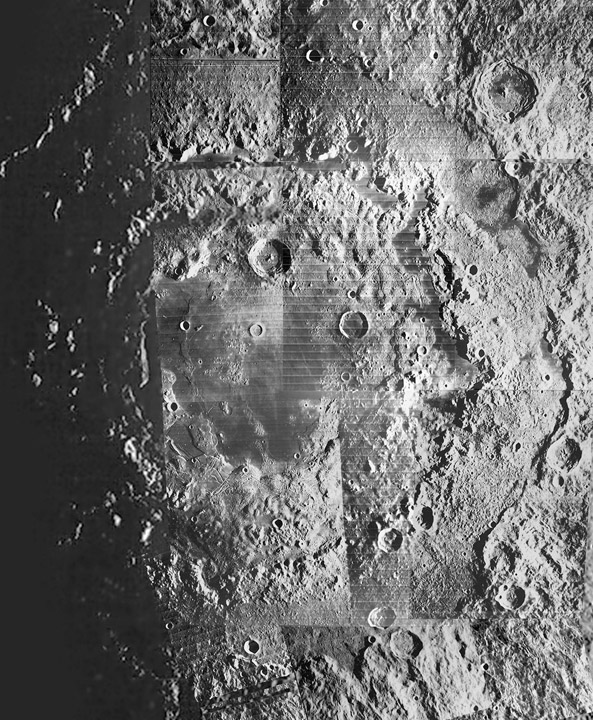
image by Lunar Orbiter IV and mosaicked by Stefan Lammel
The most spectacular sight on the Moon is out of view of Earthlings, but tantalizingly near, just over the western limb. The Orientale impact basin is the youngest large impact basin on the Moon and possibly in the entire solar system. Fortunately it was not submerged by lava so that much of the floor structure of a large basin is clear to see. Or it would be if there were a high resolution image. Unfortunately, the basin is so large (930 km across the Cordillera rim) that the entire structure is only visible in a famous, but only medium resolution, Orbiter IV image. Stefan has now provided the high resolution view that has been needed for nearly 40 years by using amateur mosaic making techniques to stitch together the high res Lunar Orbiter IV frames. This image beautifully shows the two inner rings - the Outer and Inner Rook Mountains - and the lava that leaked to the surface just inside the Outer Rook. Orientale is assumed to be what Imbrium and other basins looked like when they were young and not yet covered by kilometers of mare lava. But I am not sure that if lavas had flooded the floor of Orientale so that only the tallest peaks of the Outer Rook were exposed that they would look like Imbrium’s Pico and Piton. But maybe they would; when we finally get high res digital topography of the Moon we can accurately flood Orientale with virtual lava and look from the surface to see what the Rook peaks look like. I can’t wait.
Technical Details:
Stefan writes: I tried to mosaic the Lunar Orbiter images with the automated program Autostitch which many people have had success with, but I dont seem to have much luck with this program and it didnt work at all, I think there was not enough overlap between the images. So it was a case of doing it the hard way, manually in Photoshop. There are 12 full size LO images here which have the side registration marks removed then superimposed on a background full area image (IV-187-M) so I could get an idea of how the jigsaw fits together and to fill in the gaps between and outside the frames. The lighting/exposure varies a great deal between many of the frames so I adjusted each one to match as much possible, but I wasnt able to remove it completely.
Related Links:
Rükl chart VII
Stefan’s website
Yesterday's LPOD: Robotic Moon
Tomorrow's LPOD: Apollo 11 + 37 Years
COMMENTS?
Register, Log in, and join in the comments.



